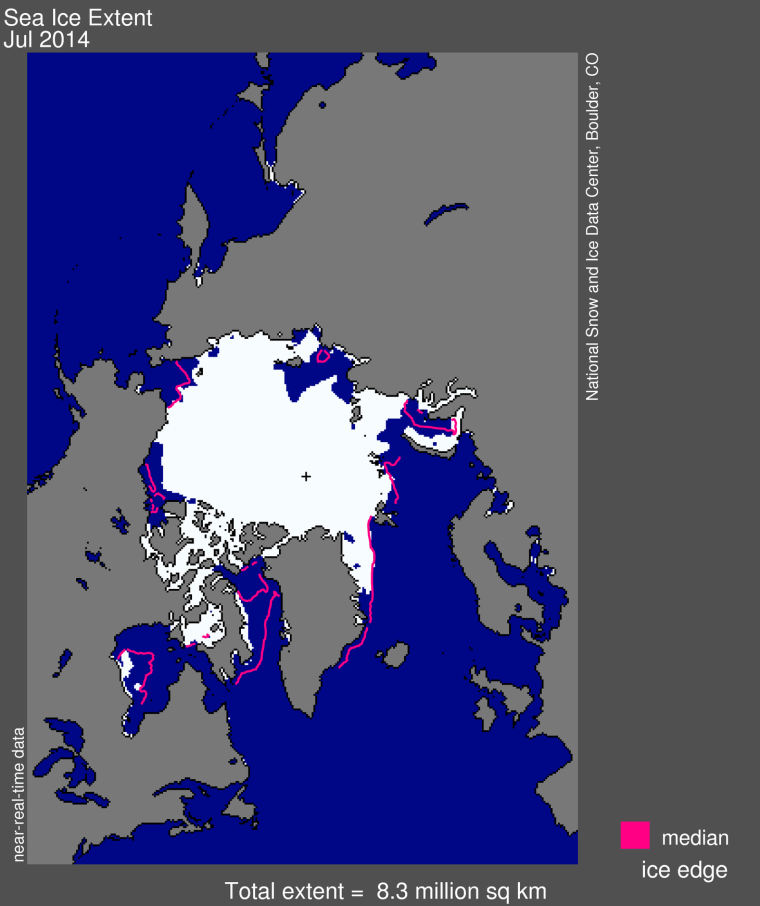Monster waves should be added to the list of hazards faced by ship captains as they plot a course through the waters of the Arctic Ocean, according to a new study that reports observations of house-sized swells in seas that until recently were covered in ice year-round.
"Waves always pose a risk to working at sea," study author Jim Thomson, an oceanographer at the University of Washington in Seattle, said via email to NBC News from off the coast of northern Alaska. "The unique thing about the Arctic is that it is changing so rapidly that we cannot apply past measurements to understand future risk."
The minimum extent of summer sea ice in the Arctic has been on a downward trend since satellite observations began in 1979. A record minimum was reached on September 16, 2012, of 1.32 million square miles, which was 49 percent below the 1979 to 2000 average, according to the National Snow and Ice Data Center in Boulder, Colorado.
As the sea ice retreats each summer, the open waters of the Arctic are a lure to shipping companies in search of a faster route between Europe and Asia as well as oil and gas companies eager to exploit newly accessible natural resources.
In 2013, for example, 71 vessels plied the Northern Sea Route, an approximate 3,000-mile voyage along the Russian Arctic coast. Hundreds more go up to the Arctic for a specific purpose, such as to deliver equipment to mines and leave with bulk commodities such as nickel and iron ore.
Experts expect ship traffic in the Arctic to steadily increase in the coming years, but the reality of working in waters that are littered with ice floes, dark half the year, and all but empty of infrastructure has tempered enthusiasm for the new frontier.
"It is a tough place to work and it is going to continue to be a tough place to work because even in an ice-diminished Arctic Ocean these are still pretty treacherous waters," Mark Serreze, director of the National Snow and Ice Data Center, told NBC News. He said the new research, which he was not part of, highlights the risk of waves and suggests how the rough waters could accelerate the sea ice retreat.

Accelerating the Retreat
Scientists have long predicted that as the Arctic Ocean becomes more open each summer, waves would get bigger. More open water, known as fetch, gives the winds — which have always howled through the Arctic — more area to blow across and kick up the seas. "Our measurements confirm this," said Thomson, who collected the data with a sensor deployed in the middle of the Beaufort Sea about 350 miles off Alaska's North Slope in the summer of 2012.
The biggest waves — measured at 16 feet, about the height of a one-story house — formed during a storm that September with 40-mile-per-hour winds and evolved from waves into sea swell. "This had not been shown because no other ocean experiences such drastic changes in fetch as the Arctic Ocean, especially in recent years," Thomson added.
He and colleague Erick Rogers from the Naval Research Laboratory at Stennis Space Center in Mississippi write in their paper published in the journal Geophysical Research Letters that even further reduction of sea ice cover in the future should "result in larger waves, which in turn provide a mechanism to break up sea ice and accelerate ice retreat."
Several climate models suggest that the Arctic Ocean will be seasonally ice free by the middle of this century. The breakup of the sea ice from the waves, Serreze said, "should accelerate the timeframe." While the latest generation climate models have ocean waves in them, the more this mechanism is understood, the more robust the predictions of ice free waters will become, he added.
Slowing Ships, Hammering Shores
The increasingly bigger waves in the increasingly open waters of the Arctic each summer are "not going to shut down the shipping, just make it more challenging," Lawson Brigham, a professor of geography and Arctic policy at the University of Alaska, Fairbanks, told NBC News. As big waves do in every other ocean, they force ships to travel more slowly.
In fact, the combination of big waves in waters that will continue to have chunks of ice floating about even in so-called ice-free conditions will cause ships to travel more slowly across the Arctic than they would elsewhere. "And that defeats the purpose" of shipping across the top of the world instead of other routes, such as through the Suez and Panama canals, Brigham noted.
An even bigger impact from the waves, he said, is likely to fall on coastal communities in the Arctic. "These greater waves, once they reach the beach, the energy just tears the beach apart."